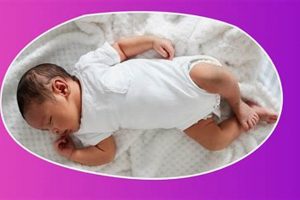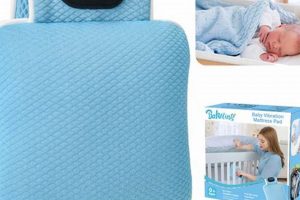The UPPAbaby bassinet is designed as a safe sleep solution for infants during the early months. It provides a flat, secure surface that adheres to established safety standards for newborn sleep. The bassinet’s construction and materials are specifically chosen to promote airflow and minimize potential hazards.
Utilizing a bassinet offers several advantages, including portability, which allows caregivers to move the baby from room to room while maintaining a consistent sleep environment. Historically, bassinets have been used for centuries, providing a contained and easily accessible space for newborns. Modern bassinets, such as the UPPAbaby model, incorporate updated safety features and materials for enhanced infant well-being.
This article will delve into the specific features of the UPPAbaby bassinet, exploring its suitability for overnight sleep, recommended usage guidelines, and essential safety considerations for optimal infant care.
Guidance for Bassinet Use
Optimizing infant safety during sleep necessitates adherence to established guidelines and a thorough understanding of the product’s intended use. This section outlines key considerations for utilizing the UPPAbaby bassinet.
Tip 1: Adhere to Weight and Age Limits: The UPPAbaby bassinet is designed for infants meeting specific weight and age criteria. Exceeding the maximum weight limit or continuing use beyond the recommended age poses a safety risk. Always consult the manufacturer’s guidelines for the precise limits.
Tip 2: Ensure Proper Ventilation: Adequate airflow is crucial for infant safety. Position the bassinet in a well-ventilated area, away from direct sunlight or sources of excessive heat. Do not cover the bassinet with blankets or other materials that could restrict airflow.
Tip 3: Use on a Stable, Flat Surface: Place the bassinet on a level, stable surface to prevent tipping or rolling. Avoid using it on uneven ground, soft bedding, or surfaces that could compromise its stability.
Tip 4: Regularly Inspect the Bassinet: Periodically examine the bassinet for any signs of damage, loose parts, or wear and tear. Address any issues promptly to ensure the bassinet remains in a safe and functional condition. Check the mattress pad for proper fit and firmness.
Tip 5: Follow Safe Sleep Practices: Always place the infant on their back to sleep, following the recommendations of pediatricians and safe sleep organizations. Avoid using pillows, blankets, or toys in the bassinet, as these can pose a suffocation hazard.
Tip 6: Supervise Infant During Use: While the UPPAbaby bassinet offers a safe sleep environment, continuous supervision is essential. Regularly check on the infant and respond promptly to any signs of distress.
Tip 7: Refer to the Instruction Manual: Thoroughly review the UPPAbaby instruction manual for detailed information on assembly, usage, and safety precautions. Adhering to the manufacturer’s instructions is paramount for ensuring the bassinet is used correctly.
These guidelines promote a secure and comfortable sleep environment for the infant. Strict adherence to these recommendations is crucial for minimizing potential risks and maximizing the benefits of the UPPAbaby bassinet.
The following sections will address potential concerns and provide further clarification on the safe and effective use of this product.
1. Safe Sleep Guidelines and the UPPAbaby Bassinet
Safe sleep guidelines are paramount when determining if an infant can sleep in a UPPAbaby bassinet. These guidelines, established by pediatric and safety organizations, aim to minimize the risk of Sudden Infant Death Syndrome (SIDS) and other sleep-related fatalities. The UPPAbaby bassinet’s suitability for infant sleep hinges on its compliance with, and support of, these guidelines.
- Firm, Flat Sleep Surface
Safe sleep guidelines emphasize the necessity of a firm, flat sleep surface for infants. This reduces the risk of suffocation and ensures proper spinal alignment. The UPPAbaby bassinet is designed with a firm mattress pad that meets these requirements. Using additional padding or soft bedding is contraindicated, as it violates this crucial safety tenet. A compliant sleep surface is a foundational element of SIDS prevention.
- Back Sleeping Position
Placing an infant on their back to sleep is a cornerstone of safe sleep practices. This position significantly reduces the risk of SIDS. The UPPAbaby bassinet’s design facilitates placing and maintaining the infant in the supine position. Caregivers must consistently adhere to this practice. Deviating from this recommendation increases the risk of adverse outcomes.
- Bare Crib Environment
A bare crib environment, free of loose blankets, pillows, toys, and bumpers, is another essential element of safe sleep guidelines. These items pose a suffocation hazard. The UPPAbaby bassinet should be used without any additional items that could compromise the infant’s airway. The absence of extraneous items ensures a safer sleep environment.
- Room Sharing, Not Bed Sharing
Safe sleep guidelines recommend room sharing, where the infant sleeps in the same room as the caregivers, but not in the same bed. This proximity allows for easier monitoring and intervention if needed. The portability of the UPPAbaby bassinet enables caregivers to easily move the bassinet between rooms, facilitating room sharing. Bed sharing, however, is strongly discouraged due to the increased risk of SIDS.
These facets of safe sleep guidelines directly influence the safe utilization of the UPPAbaby bassinet. Adherence to these recommendations is not merely advisable but crucial for ensuring infant safety. The design of the bassinet supports these guidelines; however, caregiver compliance is the ultimate determinant of a safe sleep environment.
2. Bassinet Weight Limits
Bassinet weight limits are a critical safety parameter directly influencing whether an infant can safely sleep in a UPPAbaby bassinet. These limits are established by the manufacturer to ensure the structural integrity of the bassinet and to prevent potential hazards associated with exceeding its load-bearing capacity. Adherence to these limits is non-negotiable for safe usage.
- Structural Integrity and Stability
Exceeding the specified weight limit compromises the structural integrity of the bassinet frame and support system. This can lead to instability, increasing the risk of tipping or collapse. For instance, if the UPPAbaby bassinet has a weight limit of 20 pounds, placing an infant weighing more than that puts undue stress on the frame, potentially causing it to buckle or break. The ramifications include potential injury to the infant from a fall or entrapment.
- Mattress Support and Infant Safety
The bassinet mattress is designed to provide a firm, flat sleep surface conducive to infant safety. Exceeding the weight limit can cause the mattress to sag or deform, compromising this critical feature. A sagging mattress may create an unsafe sleep environment, potentially leading to suffocation or airway obstruction. In such scenarios, the UPPAbaby bassinet no longer provides the intended safe sleep space.
- Adverse Product Performance
Weight limits are based on rigorous testing conducted by the manufacturer to ensure the product performs as intended under specific conditions. Exceeding these limits voids the warranty and increases the likelihood of adverse product performance. This includes but is not limited to frame failure, fabric tearing, and detachment of components. If a bassinet is used beyond its weight capacity and fails, the manufacturer is not liable for any resulting injuries.
- Transition to Alternative Sleep Arrangements
When an infant approaches or exceeds the UPPAbaby bassinet’s weight limit, it is imperative to transition the child to an alternative, more appropriate sleep arrangement, such as a crib or toddler bed. Delaying this transition poses unnecessary risks. It is the caregiver’s responsibility to monitor the infant’s weight and development and to make timely adjustments to ensure the infant continues to sleep in a safe and suitable environment.
The weight limits associated with the UPPAbaby bassinet are not arbitrary; they are carefully calculated to ensure the safety and well-being of the infant. Ignoring these limits undermines the intended safety features of the product and places the infant at risk. Proper adherence to weight restrictions is a fundamental prerequisite for using the UPPAbaby bassinet as a safe sleep space.
3. Proper Ventilation Importance
Adequate ventilation is a critical factor in determining the suitability of the UPPAbaby bassinet for infant sleep. Proper airflow minimizes the risk of carbon dioxide buildup and overheating, both of which pose significant threats to infant health and safety. The bassinet’s design and usage must facilitate optimal air circulation.
- Reduced Risk of Suffocation
Proper ventilation diminishes the risk of suffocation by ensuring a constant supply of fresh air. Enclosed spaces with limited airflow can lead to a buildup of carbon dioxide, displacing oxygen and potentially causing respiratory distress. The UPPAbaby bassinet should be positioned in a well-ventilated area, and any coverings or obstructions that could impede airflow must be avoided. The bassinet’s inherent design must allow for unrestricted air exchange to mitigate suffocation risks.
- Thermoregulation and Overheating Prevention
Infants have limited capacity to regulate their body temperature, making them particularly vulnerable to overheating. Proper ventilation aids in thermoregulation by dissipating excess heat and maintaining a comfortable sleeping environment. The UPPAbaby bassinet should not be placed in direct sunlight or near heat sources, and lightweight, breathable fabrics should be used for bedding to prevent overheating. Adequate ventilation is essential for maintaining a safe and stable body temperature during sleep.
- Moisture Control and Hygiene
Proper ventilation helps to control moisture levels within the bassinet, preventing the growth of mold and bacteria. Poorly ventilated environments can trap moisture, creating a breeding ground for harmful microorganisms that can compromise infant health. The UPPAbaby bassinet should be regularly cleaned and aired out to maintain a hygienic sleep environment. Ventilation plays a crucial role in reducing humidity and preventing the proliferation of pathogens.
- Design Features and Airflow
The UPPAbaby bassinet’s design incorporates features that promote airflow, such as breathable fabrics and strategically placed ventilation openings. Caregivers should ensure that these features are not obstructed and that the bassinet is positioned in a manner that maximizes air circulation. Understanding and utilizing these design elements are essential for optimizing ventilation and ensuring a safe sleep environment for the infant. The bassinet’s construction is intended to work in conjunction with proper placement and usage to maintain adequate airflow.
In conclusion, the importance of proper ventilation cannot be overstated when considering whether an infant can safely sleep in the UPPAbaby bassinet. A well-ventilated environment reduces the risk of suffocation, aids in thermoregulation, controls moisture, and supports overall hygiene, all of which contribute to a safer and healthier sleep experience for the infant. Compliance with ventilation guidelines is a fundamental aspect of responsible bassinet usage.
4. Stable Surface Requirement
The requirement for a stable surface is inextricably linked to the safe utilization of the UPPAbaby bassinet for infant sleep. A stable surface provides the necessary foundation to prevent tipping, rolling, or other hazardous movements that could compromise the infant’s safety. The absence of a stable base can directly lead to injuries or fatalities, underscoring its critical importance.
The UPPAbaby bassinet is designed to be placed on a level, firm surface. This ensures the weight is evenly distributed, minimizing the risk of instability. Examples of unsuitable surfaces include uneven flooring, soft bedding, or inclined planes. Placing the bassinet on such surfaces can cause it to tilt, potentially leading to the infant rolling into an unsafe position or the entire structure collapsing. The practical significance of this understanding is that caregivers must actively assess and select appropriate surfaces for bassinet placement to mitigate potential risks.
Ultimately, the connection between a stable surface requirement and the safe use of the UPPAbaby bassinet is a fundamental safety principle. Neglecting this requirement directly increases the risk of accidents and injuries. Consistent adherence to this guideline is essential for ensuring the bassinet provides a secure and supportive sleep environment, thereby supporting the overall well-being of the infant.
5. Regular Inspection Necessary
Regular inspection of the UPPAbaby bassinet is paramount to ensuring a safe sleep environment for an infant. This proactive measure addresses potential hazards that may arise from wear and tear, misuse, or manufacturing defects. Neglecting regular inspection compromises the structural integrity and safety features of the bassinet, directly impacting the well-being of the child.
- Structural Integrity Assessment
Routine inspection should include a thorough assessment of the bassinet’s frame, joints, and support system. Look for cracks, bends, or loose connections that could compromise its stability. For example, if the bassinet frame exhibits hairline fractures, it may collapse under the infant’s weight. Failure to identify and address structural issues renders the bassinet unsafe for infant sleep.
- Fabric and Material Condition
Inspect the fabric covering, mattress pad, and any other soft components for rips, tears, or loose threads. These defects can pose a suffocation hazard or entrapment risk. If the mattress pad is torn, the infant could become entangled in the exposed material. Regular checks ensure that all fabric elements remain intact and secure.
- Hardware Functionality
Examine all hardware components, such as fasteners, straps, and locking mechanisms, to ensure they are functioning correctly. Faulty hardware can lead to unexpected detachment or collapse. If a strap buckle is broken, it could fail during use, causing the bassinet to become unstable. Verifying the integrity of all hardware is essential for maintaining the bassinet’s functionality and safety.
- Compliance with Safety Standards
Regular inspection should also include verifying that the bassinet continues to meet current safety standards. Check for recalls or safety alerts issued by the manufacturer or regulatory agencies. If a recall notice is issued for a specific model due to a safety defect, the bassinet should be immediately removed from use and the manufacturer contacted for remediation. Maintaining compliance with safety standards is a continuous process that requires diligent monitoring.
The components described are essential to determine the safety of the baby inside UPPAbaby bassinet. Regular inspections are essential to identifying issues before they become potentially dangerous.
6. Manufacturer's Instructions Compliance
Adherence to the manufacturer’s instructions is a cornerstone of safe infant sleep when utilizing the UPPAbaby bassinet. The instructions provided by the manufacturer are not merely suggestions; they are the result of rigorous testing, engineering design, and safety considerations intended to minimize risks associated with infant sleep. Non-compliance directly increases the likelihood of product malfunction, improper usage, and potential harm to the infant. The manufacturer’s instructions provide critical information regarding assembly, usage limitations (weight, age), and safety precautions. Failure to follow these instructions negates the safety measures built into the product design.
Consider, for example, the proper assembly of the bassinet stand. The manufacturer’s instructions detail the precise steps required to securely attach the bassinet to the stand. If these instructions are ignored, and connections are not properly secured, the stand may collapse, causing the bassinet to fall and potentially injure the infant. Similarly, the instructions specify the maximum weight limit for the bassinet. Exceeding this weight limit can cause the bassinet’s frame to buckle, leading to instability and posing a risk of suffocation or injury. Compliance with recommended cleaning procedures is also crucial. Using improper cleaning agents or techniques can damage the bassinet’s materials, potentially releasing harmful chemicals or compromising its structural integrity.
Ultimately, utilizing the UPPAbaby bassinet for infant sleep requires a commitment to understanding and following the manufacturer’s instructions. These instructions serve as a critical guide to ensure the product is used safely and effectively. Ignoring these guidelines increases the risk of adverse outcomes and compromises the safety and well-being of the infant. The manufacturer’s instructions are not optional; they are an integral component of safe infant sleep practices when using this product.
7. Supervision essential
Continuous infant supervision is an indispensable element when considering the UPPAbaby bassinet as a sleep solution. While the bassinet provides a defined and, when correctly utilized, a safe sleep space, it does not eliminate the need for vigilance. The importance of active monitoring is amplified by the inherent vulnerabilities of infants and the potential for unforeseen circumstances.
- Respiratory Monitoring
Infants, particularly newborns, may experience periods of irregular breathing. Consistent visual and auditory monitoring allows caregivers to detect signs of respiratory distress, such as gasping, apnea, or changes in skin color. Prompt intervention, including repositioning or seeking medical assistance, can be critical. The bassinet’s proximity to the caregiver facilitates this continuous assessment.
- Entrapment and Positioning
Although the UPPAbaby bassinet is designed with safety in mind, there remains a possibility of the infant shifting position and becoming entrapped against the sides or becoming entangled in loose bedding, if present. Regular supervision enables caregivers to identify and correct these situations, preventing potential suffocation or injury. Vigilance ensures the infant remains in a safe sleeping position.
- Early Detection of Illness or Discomfort
Changes in an infant’s behavior, such as increased restlessness, unusual crying, or signs of fever, can indicate illness or discomfort. Regular observation allows caregivers to detect these early warning signs and respond appropriately, whether by providing comfort, adjusting the environment, or seeking medical attention. Early detection and intervention can prevent the escalation of minor issues into more serious health concerns.
- Environmental Hazard Mitigation
Even in a carefully prepared sleep environment, unforeseen hazards can arise, such as changes in room temperature, drafts, or the presence of small objects that could pose a choking risk. Active supervision enables caregivers to identify and address these hazards promptly, ensuring the infant’s continued safety and comfort. Maintaining a safe sleep environment is an ongoing process that requires constant attention.
Therefore, while the UPPAbaby bassinet can offer a safe and convenient sleep space, it serves as a tool within a broader framework of responsible infant care. Continuous supervision is not merely recommended; it is an essential component of ensuring the infant’s safety and well-being. This vigilance complements the bassinet’s features, creating a comprehensive approach to infant sleep safety.
Frequently Asked Questions
The following questions address common inquiries and concerns regarding the use of the UPPAbaby bassinet for infant sleep. The responses are intended to provide clear and informative guidance based on established safety recommendations and product specifications.
Question 1: Is the UPPAbaby bassinet suitable for overnight sleep?
The UPPAbaby bassinet is designed and tested to meet safety standards for overnight infant sleep, provided all manufacturer guidelines and safe sleep practices are strictly followed. This includes adhering to weight limits, ensuring proper ventilation, and utilizing a firm, flat sleep surface.
Question 2: What are the weight and age restrictions for using the UPPAbaby bassinet?
The UPPAbaby bassinet is typically suitable for infants up to 20 pounds or until they can push up on their hands and knees, whichever comes first. Consult the specific model’s instruction manual for precise weight and age limits, as these may vary.
Question 3: How should the UPPAbaby bassinet be positioned for safe infant sleep?
The UPPAbaby bassinet should be placed on a stable, level surface away from potential hazards, such as stairs or heat sources. Ensure adequate ventilation and avoid placing the bassinet in direct sunlight or drafty areas. The bassinet should be positioned to allow for easy monitoring of the infant.
Question 4: What type of bedding is recommended for the UPPAbaby bassinet?
Only use the mattress pad provided by UPPAbaby specifically designed for the bassinet. Avoid using extra padding, blankets, pillows, or toys in the bassinet, as these can pose a suffocation hazard. A fitted sheet designed for the bassinet mattress is permissible.
Question 5: How often should the UPPAbaby bassinet be inspected for safety?
The UPPAbaby bassinet should be inspected regularly for any signs of damage, loose parts, or wear and tear. Check the frame, fabric, and hardware components to ensure they are in good working order. Any issues identified should be addressed immediately.
Question 6: What are the key safe sleep practices to follow when using the UPPAbaby bassinet?
Always place the infant on their back to sleep. Ensure the bassinet is free of any loose bedding, pillows, or toys. Maintain a smoke-free environment and room-share with the infant, but avoid bed-sharing. Adhere to the manufacturer’s instructions for proper assembly and usage.
These FAQs emphasize the importance of adhering to both manufacturer guidelines and established safe sleep practices when using the UPPAbaby bassinet for infant sleep. Responsible usage is paramount for ensuring the infant’s safety and well-being.
The subsequent section will discuss the proper maintenance and cleaning procedures for the UPPAbaby bassinet.
Can Baby Sleep in UPPAbaby Bassinet
This article comprehensively examined the question of whether an infant can sleep in an UPPAbaby bassinet. The investigation revealed that the UPPAbaby bassinet is designed to be a safe sleep environment for infants when used according to the manufacturer’s instructions and in adherence to established safe sleep guidelines. Critical factors include adhering to weight limits, ensuring proper ventilation, maintaining a stable surface, conducting regular inspections, following all instructions, and providing consistent supervision. Deviations from these recommendations increase risk and potentially compromise infant safety. It is found that a bassinet is safe when proper practices are being followed.
The decision regarding infant sleep arrangements is a significant responsibility. Caregivers must prioritize safety above all else. While the UPPAbaby bassinet offers a viable option, its suitability depends entirely on responsible usage and unwavering adherence to safety protocols. Ongoing awareness and proactive measures are essential for ensuring the well-being of infants during sleep. Furthermore consult with pediatricians for any further concern.







